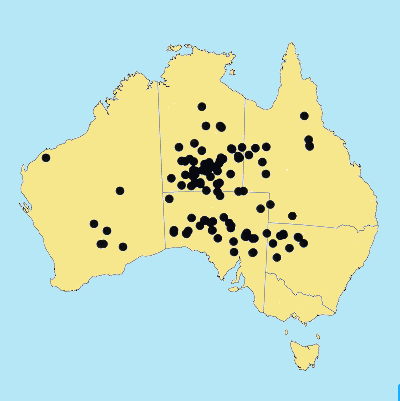Enneapogon cylindricus N. T. Burbidge. Proc.
Linn. Soc. London 153: 89 (1941).
Classification. (GPWG 2001) : Subfamily
Chloridoideae. Pappophoreae.
Type of Basionym or
Protologue Information: Australia: South Australia: Frome Downs, Wade 26
(HT: K).
Recent synonyms:
E. asperatus.
Key references
(books and floras): [1952] C.A.Gardner, Flora of Western Australia 1
Gramineae (33), [1981] M.Lazarides in J.Jessop (ed)., Flora of
Central Australia (455 & as E. asperatus), [2002] D.Sharp &
B.K.Simon, AusGrass, Grasses of Australia, [2006] J.Jessop,
G.R.M.Dashorst, F.M.James, Grasses of South Australia (332), [2008]
S.W.L.Jacobs, R.D.B.Walley & D.J.B.Wheeler, Grasses of New South Wales
(240).
Illustrations:
[2005] K.Mallet (ed.), Flora of Australia 44B: Poaceae 3 (Fig.
29A-E), [2006] J.Jessop, G.R.M.Dashorst, F.M.James, Grasses of South
Australia (333, Fig. 265 & plate
12), [2008] S.W.L.Jacobs, R.D.B.Whalley & D.J.B.Wheeler, Grasses of New
South Wales, 4th edn (240).
Habit.
Perennial. Culms stature slender to delicate, 10–51 cm tall, 3–4 -noded.
Mid-culm internodes pubescent or pilose. Lateral branches simple or sparsely
branched. Ligule a fringe of hairs. Leaf-blades involute, 1–2 mm wide.
Leaf-blade surface indumented.
Inflorescence.
Inflorescence solid, a panicle. Panicle linear, 3–14 cm long, 0.5–1.5 cm wide.
Spikelets.
Spikelets pedicelled. Fertile spikelets 1 or more flowered, with 1 fertile
floret, comprising 1 fertile floret(s), with diminished florets at the apex,
oblong, laterally compressed, 3–7 mm long.
Glumes. Glumes
similar, thinner than fertile lemma. Lower glume ovate, membranous, without
keels, 4–8 -nerved. Lower glume surface indumented. Lower glume apex muticous
or mucronate. Upper glume ovate, 2.5–7 mm long, membranous, without keels, 4–8
-nerved. Upper glume surface indumented. Upper glume apex entire or erose,
muticous or mucronate.
Florets.
Fertile lemma 1.8–2.3 mm long, without keel, 9–11(–13) -nerved. Lemma surface
indumented. Lemma apex dentate or lobed, awned, 9 -awned. Median (principal)
awn 1.5–5.4 mm long overall. Lateral lemma awns present. Palea apex dentate,
muticous or with excurrent keel nerves or awned. Lodicules present. Anthers 3.
Grain 1–2 mm long.
Continental
Distribution: Australasia.
Australian
Distribution: Western Australia, Northern Territory, South Australia,
Queensland, New South Wales.
Western Australia:
Mueller, Giles, Austin. Eucla, Coolgardie. Northern Territory: Barkly
Tableland, Central Australia North, Central Australia South. South Australia:
North-western, Lake Eyre, Nullabor, Gairdner-Torrens Basin, Flinders Ranges,
Eastern, Eyre Peninsula. Queensland: Cook, Burke, North Kennedy, Gregory
North, Gregory South, Mitchell. New South Wales: North Far Western
Plains, South Far Western Plains.
Notes.
Readily recognised by articulate culms, linear panicle and axillary spikelet. E.
asperatus, treated here as a synonym, appears to be a localized variant
with strongly branching habit and usually smaller dimensions in panicle and
fertile floret.
Arid
regions of all mainland states except Vic. Often occurs on skeletal desert
soils, limestone, rocky, sandy or clayey soils, with Mulga (Acacia aneura),
bluebush (Maireana sedifolia) or other shrubs and grasses; flowers
Mar.-Aug.





